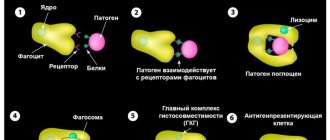What kind of cells are neutrophils?
Neutrophilic leukocytes or neutrophils are the most numerous type of white blood cells.
They are formed in the bone marrow, where they undergo a series of stages during maturation. A myeloblast is formed from a precursor cell. The next cell is the promyelocyte. From it a myelocyte is formed, and then a metamyelocyte. These neutrophils are called juveniles. From them, rod forms mature. Further, mature cells – segmented neutrophils – are formed from them.
All types of neutrophil leukocytes differ from each other at different stages: the shape of the nucleus, the presence of granules. For example, segmented neutrophils contain a nucleus divided into segments.
The granules contained in the cytoplasm of neutrophils provide their ability to perform their biological functions.
The presence of granules in the cytoplasm of neutrophils allows them to be classified as granulocytic leukocytes. In addition to neutrophils, they also include eosinophils and basophils.
The main task of these cells is to fight foreign agents that enter our body. Therefore, there is a relationship between the content of these leukocytes and the presence of an infectious process.
Photo: https://moyakrov.info/blood/prichiny-povysheniya-ili-ponizheniya-segmentoyadernyh-nejtrofilov
Norms for neutrophil levels in children
The normal content of neutrophils in children is presented in Table 1. There are two main types of neutrophil leukocytes: band and segmented. Also, the units of measurement of a given type of cell will be presented in the form of relative and absolute values.
Absolute values show the content of a given cell type in the blood, expressed as 10 * 9 per liter. Relative numbers show how many cells of a given type were detected out of 100. Then the unit of measurement will be percentages.
Table 1. Norm of neutrophils in children.
| Age group | Absolute values | Relative values | |
| Rod | Segmented | ||
| Less than one year | 1.5 – 8.5 * 10*9/liter | 0,5 – 4 % | 15 – 45 % |
| One year – six years | 1.5 – 8.5 * 10*9/liter | 0,5 – 5 % | 25 – 60 % |
| From seven to twelve years | 1.8 – 8 * 10*9/liter | 0,5 – 5 % | 35 – 65 % |
| Over thirteen years old | 1.8 – 7.7 * 10*9/liter | 0,5 – 6 % | 47 – 72 % |
What do low neutrophils mean?
The normal blood content of segmented neutrophils in children over 5 years of age and adults is 47-72%; in a child under 5 years of age this value will range from 19 to 37 percent.
There are three types of neutropenia:
- Hereditary.
- Congenital.
- Purchased.
Hereditary - transmitted from generation to generation and may not affect the general condition in any way - this is an individual feature. Congenital abnormalities of the immune system and other disorders contribute to the progression of neutropenia, which affects the functioning of the entire body.

Manual counting of blood cells under a microscope
There are several mechanisms by which segmented neutrophil levels may be low:
- reduction of synthesis or its distortion (as a result of improper functioning of the bone marrow, the number or quality of the resulting cells decreases);
- redistribution (segmented neutrophils actively move to the site of the inflammatory process and leave the blood for the body tissues);
- high death and elimination (in the case when immune cells die in too large quantities or the body independently destroys low-quality, pathological forms).
Why are neutrophils low in a child?
The majority of neutrophils are segmented. Therefore, the reasons that segmented cells are reduced may be:
- disruption of the formation of neutrophil leukocytes in the bone marrow , for example, as a result of a malignant process;
- rapid death of neutrophils after performing their function - destroying the infectious agent. That is, with an excess of pathogenic agents, the body does not have time to produce new cells, their content decreases;
- a change in the number of other types of white blood cells , resulting in a change in the relative importance of the cells. Therefore, in this case it is better to take into account the absolute values of cells in the blood.
A decrease in the number of neutrophil leukocytes is called neutropenia.
Thus, the presence of some infectious diseases is accompanied by the fact that segmented neutrophils are reduced in children. Examples of such diseases may be:
- rubella;
- hepatitis;
- chickenpox;
- flu;
- fungal infection and others.

Photo: https://pixabay.com/photos/cold-headaches-health-influence-3861935/
Reasons for the decline
A low content may be a physiologically determined norm and not cause concern, but there are many more cases when the level of cells is reduced, which is a sign of serious pathology. The main reasons why the number of segmented neutrophils is underestimated include:
- viral and bacterial infections;
- “secondary wasting neutropenia” (a severe condition that occurs after a prolonged strong immune response);
- metabolic disorders;
- deficiency of essential vitamins, protein-energy deficiency in diseases such as kwashiorkor, severe iron deficiency anemia;
- pancytopenia is a condition in which the amount of all elements in the blood is reduced;
- reaction to the use of certain drugs (non-steroidal anti-inflammatory drugs);
- primary and secondary aplastic conditions (suppression or cessation of the synthesis and maturation of new cells in the bone marrow).
As a rule, any changes in the leukocyte formula are acute and extremely dangerous conditions, which require special caution from parents. It is extremely important to monitor the dynamics of the development of the process so as not to miss the moment and start treatment on time.
When children are referred for testing
Determining the level of neutrophils in the blood is included in such an indicator as the leukocyte formula. It involves counting the types of leukocytes. The calculation of the leukocyte formula is most often included in the CBC (general clinical blood test).
The purpose of this blood test is to:
- assess the child’s condition in the absence of any complaints during a routine examination;
- identify the presence of an infectious process if it is suspected, especially when there are clinical manifestations;
- identify disorders of blood cell content as a result of a hereditary disorder or tumor process.
That is, the CBC is a simple but quite informative blood test, which is prescribed for preventive purposes, as well as for any disease.
Against the background of high lymphocytes
In young children, the leukocyte formula is normally different. Up to 4-5 years (at this age there is a physiological crossover, when the value becomes the same as in an adult), the relative content of lymphocytes is 47-72%. Then they gradually decrease, changing places with leukocytes.
If, after passing this milestone, the child has a large number of lymphocytes and the level of segmented neutrophils is reduced, then a viral or severe specific bacterial infection should be suspected. If there are no symptoms, then the disease may simply proceed in a latent form. But it must be taken into account that after a serious illness, residual effects in a blood test can persist for up to a month.
A reduced number of segments against the background of lymphocytosis accompanies such serious diseases as hepatitis, measles, rubella, whooping cough, tuberculosis and even HIV infection. Given the unhealthy tendency of parents not to vaccinate their children, the problem is becoming increasingly urgent.
The combination of low segmented neutrophils and lymphocytosis occurs with helminthiases, and an important criterion in diagnosis is the number of eosinophils.
If the results of laboratory tests are not normalized, then this is a serious reason to undergo additional examination for a hidden pathological process.
Preparing for analysis
In order to find out the number of neutrophil leukocytes, you need to donate blood from a finger or from a vein. This biological material must be taken on an empty stomach in children over five years of age. It is recommended not to feed infants for 30 minutes before blood sampling, and for children under five years old - for 3 to 4 hours.
It is also desirable that the patient does not experience emotional overload. Parents should motivate their child to withstand the “finger prick” and explain that there is nothing wrong with it.
Parents should also make sure that the child does not run around the hospital corridors before the blood is drawn.
The baby's hands should be warm. If they are cold, blood will flow poorly from the finger, causing discomfort to the medical staff and the child.

Photo: https://pixabay.com/photos/nurse-diabetes-diabetic-test-a1c-527615/
What level of neutrophils is considered reduced?
Neutrophils are the most numerous group of white blood cells, whose main function is to destroy pathogenic bacteria. They come in several forms:
- Young neutrophils, which are also called myelocytes and metamyelocytes. There are no such cells in the normal leukocyte formula.
- Band neutrophils (rods) . These are young cells, the lower limit of the norm in the first days of life is 5%, and from the 5th day after birth - 1%.
- Segmented neutrophils. Such mature cells are predominant among all neutrophils and normally do not decrease below the following indicators:
| In a newborn | 50% |
| From the fifth day after birth | 35% |
| 1 month old baby | 17% |
| In a one-year-old child | 20% |
| The child is 5 years old | 35% |
| In children over 10 years old | 40% |
If fewer neutrophils are detected in the blood of a small patient than should be present at his age, this is called neutropenia .
Method for determining the level of neutrophils in the blood
Most analyzes in a modern laboratory are performed by analyzers. Determination of the number of neutrophils can be done on an automatic hematology analyzer.
Another option for determining the number of neutrophil leukocytes is the manual method of calculating the leukocyte formula. A blood smear is made and stained with special dyes that allow different types of white blood cells to be identified among each other.
The microscope is then used to count 100 cells per field of view, noting which cells are seen. Then the relative value of each leukocyte found in the smear is indicated.
In a blood smear you can see different degrees of maturity of neutrophils, as well as basophils, eosinophils, lymphocytes, monocytes, and morphological features of red blood cells (size and shape).
Analysis transcript
Interpretation of the study results should only be carried out by a doctor. He will take into account all the nuances:
- what is the child’s condition at the time of treatment;
- are there any complaints;
- data from other blood or urine tests;
- child examination data;
- heredity.
In laboratory practice, high and low neutrophil values occur. It has already been indicated above what reasons may contribute to a low level of neutrophils in the blood.
A high level of neutrophils indicates that at this moment the body is fighting an infection. All the “fighters” went to fight the pathogenic agent. And this condition is called neutrophilosis.











